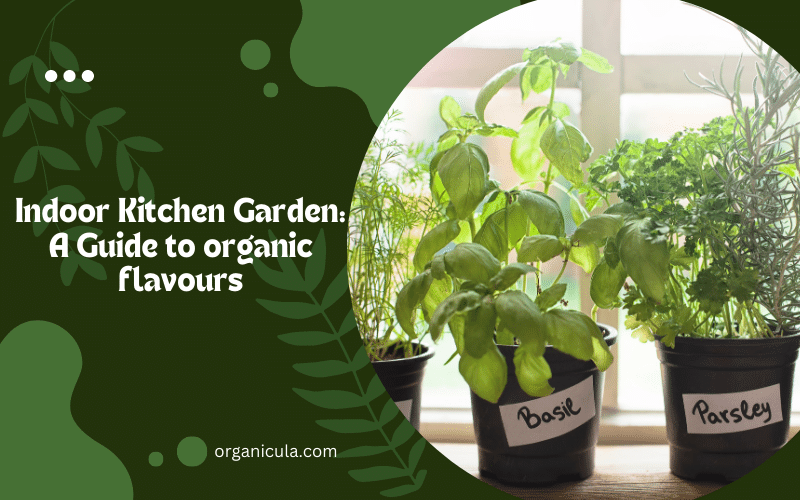An indoor kitchen garden is a beautiful way to bring fresh herbs and vegetables into your beautiful home. With some planning and care, it is possible to create a successful indoor garden that improves the look of your kitchen and gives you healthy and delicious food. Creating an indoor kitchen garden can be a fun and rewarding project. Here are some usually asked questions and answers and some tips that you can follow:
-
Choose your plants
Choose plants suitable for an indoor kitchen garden that can flourish in your home’s environment. Popular indoor plants are herbs like basil, parsley, cilantro, mint, and small vegetables like cherry tomatoes and salad greens. -
Determine the location
Choose a proper location in your home that acquires plenty of natural light, such as a balcony, windowsill or a bright corner. In addition, the location must be relatively warm, as extreme temperatures can damage plants. -
Choose your containers
Choose containers or pots for your plants per your space. Options include pots, planters, hanging baskets, and wall-mounted planters. Containers must have proper drainage and be large enough for plants to grow. -
Prepare the soil
Use a high-quality potting mix suitable for your plants. The soil must be moist but not too wet before planting. It plays a significant role in the growth of the plant. -
Plant your seeds or seedlings
Before planting the seeds, follow the instructions on the seed packets or plant labels for better planting depth and spacing. Regularly water your plants after planting. -
Provide proper care
Water your plants regularly and give them enough light. Indoor plants may require additional fertilization, so consider using a fertilizer designed for indoor plants. -
Harvest and enjoy
When your plants are mature, harvest them as needed and enjoy fresh herbs and vegetables in your cooking.
An indoor kitchen garden can provide fresh herbs and vegetables year-round, regardless of the weather outside. With the right plants, location, and care, you can create a successful indoor garden to enrich your home’s decor and culinary innovations.
Which herbs or vegetables can be grown in an indoor kitchen garden?
Several herbs and vegetables can be grown in an indoor kitchen garden. Here are some popular options:
- Herbs: Basil, parsley, cilantro, mint, chives, thyme, rosemary, oregano, and sage are the main herbs that can be grown indoors.
- Salad greens: Lettuce, arugula, spinach, and kale are all great options for indoor gardens. They can be grown quickly and can be harvested several times.
- Tomatoes: Cherry or grape tomatoes are a good option for an indoor garden, as they only take up a little space and produce fruit relatively fast.
- Peppers: Varieties of small peppers, such as mini bell peppers or chilli peppers, can be grown in an indoor garden.
- Microgreens: These are young seedlings of edible plants, such as radishes, kale, and broccoli. They are packed with nutrients and can be grown in small containers indoors.
While choosing plants for your indoor kitchen garden, consider the light they need and the available space. For example, plants like tomatoes and peppers require more space and support than others. On the other hand, herbs and microgreens can be grown in smaller containers and require less space or support. Whatever plants you choose, equip them with the proper growing conditions, like light, water, and fertilizers.
How can we maintain the good health of plants indoors?
Maintaining the health of your indoor plants is essential to ensure they flourish and produce fresh herbs and vegetables for your kitchen. Here are some tips for keeping your indoor plants healthy:
- Provide adequate light: Most indoor plants require at least six hours of sunlight daily. Ensure your plants are placed in a location with enough natural light or consider using grow lights to supplement their light requirements.
- Water properly: Overwatering can lead to root decay, while underwatering can cause plants to wither and die. Make sure you water your plants only when the top of the soil feels dry while touching, and avoid getting the leaves wet when watering.
- Monitor humidity levels: Indoor environments can be dry and may stress plants. Use a humidifier or place a water tray near your plants to increase the humidity levels.
- Provide proper ventilation: Inactive air can lead to fungal diseases and insect infestations. Ensure your plants are well-ventilated, and use a fan to circulate the air.
- Fertilize appropriately: Indoor plants require additional nutrients since they are grown in containers. Use a balanced fertilizer designed for indoor plants, and follow the instructions for application.
- Prune regularly: Pruning can boost healthy growth and control overcrowding. Regularly remove dead or yellow leaves, and pinch back stems to encourage bushier growth.
- Monitor for pests and diseases: Regularly check your plants for signs of pests or diseases, such as yellowing leaves, white powdery residue, or sticky traps. If you notice any problems, treat them promptly to stop further damage.
By following these tips, you can maintain the health of your indoor plants and provide a bountiful harvest of fresh herbs and vegetables for your kitchen.
What type of fertilizers do we require for an indoor kitchen garden?
Indoor kitchen gardens require fertilizers that are crafted specifically for indoor plants. Here are some options for fertilizers that can help keep your indoor plants healthy:
- Organic fertilizers: These are made from natural materials such as bone meal, blood meal, and fish emulsion. They release nutrients slowly and can improve soil quality over time.
- Liquid fertilizers: They are fast-acting and can be applied directly to the soil or sprayed on the leaves. They are available in both synthetic and organic formulations.
- Slow-release fertilizers: These release nutrients over a more extended period, reducing the need for frequent applications. They are available in both synthetic and organic formulations.
- Compost: Composting your kitchen scraps can provide a rich source of nutrients for your indoor plants. Mix compost into the soil or use it as a top dressing. Vermicompost is the best compost for indoor plants.
While selecting a fertilizer for your indoor kitchen garden, look for one crafted explicitly for indoor plants and follow the instructions for application carefully. Avoid over-fertilizing, which can lead to nutrient burn and plant damage. And also, provide your plants with adequate light, water, and proper growing conditions to stay healthy and productive.
Which is the best place to make an indoor kitchen garden?
The best place to create an indoor kitchen garden is in a location with ample natural light, such as a sunny windowsill or a room with south-facing windows. Choosing a location that allows your plants to receive at least 6 to 7 hours of sunlight per day is essential.
If negligible, you can supplement natural light with artificial light sources such as fluorescent or LED grow lights. These lights provide the necessary range of light plants need to grow and can be placed close to your plants to provide enough light.
Also, check the temperature and humidity of the location you choose for your indoor kitchen garden. Most herbs and vegetables prefer temperatures between 60-75°F (15-24°C) and humidity levels between 40-60%.
It is also essential to choose an easily accessible location for watering and maintenance where your plants will not be exposed to breezes or temperature fluctuations.
Eventually, the best location for your indoor kitchen garden will depend on the specific plants you choose to grow and the conditions of your home environment. However, you can create a successful indoor kitchen garden in a suitable location with carefulness and planning.

